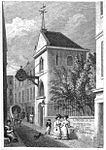Boar's Head Inn, Eastcheap

The Boar's Head Inn was a tavern in Eastcheap in the City of London which is supposed to be the meeting place of Sir John Falstaff, Prince Hal and other characters in Shakespeare's Henry IV plays. The Boar's Head Tavern is featured in historical plays by Shakespeare, particularly Henry IV, Part 1, as a favourite resort of the fictional character Falstaff and his friends in the early 15th century. The landlady is Mistress Quickly. It was the subject of essays by Oliver Goldsmith and Washington Irving. Though there is no evidence of a Boar's Head inn existing at the time the play is set, Shakespeare was referring to a real inn that existed in his own day. Established before 1537, but destroyed in 1666 in the Great Fire of London, it was soon rebuilt and continued operation until some point in the late 18th century, when the building was used by retail outlets. What remained of the building was demolished in 1831. The boar's head sign was kept, and is now installed in the Shakespeare's Globe theatre.The site of the original inn is now part of the approach to London Bridge in Cannon Street. Near the site, at 33–35 Eastcheap, the architect Robert Lewis Roumieu created a neo-Gothic building in 1868; this makes references to the Boar's Head Inn in its design and exterior decorations, which include a boar's head peeping out from grass, and portrait heads of Henry IV and Henry V. Roumieu's building originally functioned as a vinegar warehouse, though it has since been converted into offices. Nikolaus Pevsner described it as "one of the maddest displays in London of gabled Gothic brick". Ian Nairn called it "the scream you wake on at the end of a nightmare".
Excerpt from the Wikipedia article Boar's Head Inn, Eastcheap (License: CC BY-SA 3.0, Authors, Images).Boar's Head Inn, Eastcheap
King William Street, City of London
Geographical coordinates (GPS) Address Nearby Places Show on map
Geographical coordinates (GPS)
| Latitude | Longitude |
|---|---|
| N 51.51085 ° | E -0.086647222222222 ° |
Address
King William Street
King William Street
EC4R 9AD City of London
England, United Kingdom
Open on Google Maps










